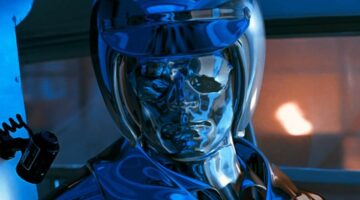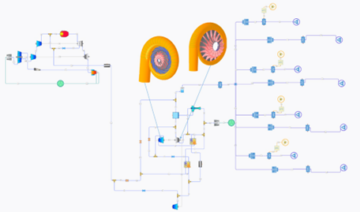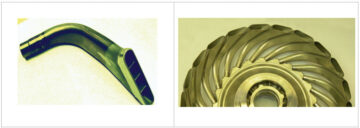The question of who invented the jet engine is often met with two different answers, and neither is really wrong. In fact, we posed this question on our LinkedIn page, and got the same mixed results seen elsewhere. Both Sir Frank Whittle and Hans von Ohain were responsible for inventing the turbojet engine at the same time. While Dr. von Ohain knew of Sir Frank’s work, he did not draw information from, while Sir Frank was unaware that anyone else was designing a turbojet engine. While we’ve covered Sir Frank Whittle before, today we’ll be looking at the life of Hans von Ohain, his invention of the turbojet, and his contributions to turbomachinery engineering.

Dr. Hans Joachim Pabst von Ohain was born on December 14, 1911 in Dessau, Germany. He went to school at the University of Göttingen where he received his PhD in Physics and Aerodynamics in 1935. During his studies and following his graduation, he was captivated by aviation and airplane propulsion, with a specific interest in developing an aircraft that did not rely on a piston-driven propeller. According to the National Aviation Hall of Fame, he “conceived the idea for jet propulsion in 1933 when he realized that the great noise and vibrations of the propeller piston engines seemed to destroy the smoothness and steadiness of flying”. (1)
As he was exploring his ideas of jet propulsion, he was working as a junior assistant to Hugo von Pohl, who was the director of the Physical Institute at the University of Göttingen. Between 1935 and 1936 while working with Von Pohl, Dr. von Ohain was ready to patent his concept and design for a jet engine. There was, however, a slight issue. Someone else had patented an engine design like what Von Ohain had in mind. In fact, “When von Ohain applied for a patent on his invention in 1936, the patent office referenced Frank Whittle’s 1930 patent, which established Whittle as the forerunner in (turbo) jet propulsion technology and development. However, since important differences existed between the two ideas, he received his patent”. (1)
A notable difference in Dr. von Ohain’s design was the turbomachinery configuration. His engine utilized a centrifugal compressor and a radial turbine which were placed very close together with the combustors around the outside of the entire assembly. As a result the engine was much shorter and wider than conventional turbojet engines.(2)
Two fortunate occurrences helped bring Dr. von Ohain’s engines to life – he was able to build a model of his engine to solidify his concept, and he began working for one of the biggest aircraft manufacturers in Germany.
Dr. von Ohain met Max Hahn, an automotive mechanic with engineering talent. Hahn agreed to build Von Ohain’s design into a model, with Ohain supplying the funds from his own pocket.(3)
During his time working at the University of Göttingen’s institute, the German aircraft magnate Ernst Heinkel was looking for assistance on an aircraft design project. Hugo von Pohl knew Heinkel, and introduced him to Dr. von Ohain. It was a critical moment for von Ohain, as his work with Heinkel helped him get his jet engines into the air.
Von Ohain began working for Heinkel in 1936, during which time he was able to continue research and development on his turbojet concept without paying out of his own pocket to do so. Until this point, both Sir Frank Whittle and Dr. von Ohain had been struggling with combustion in their engines; however this problem was resolved easily for Hans von Ohain and his team, who opted to use liquid hydrogen in their first engines.(3) This first engine was called the Heinkel-Strahltriebwerk 1, also known as the HeS1, which is German for Heinkel Jet Engine 1.
By spring 1937, the hydrogen-fueled engine ran successfully in a bench test, and with some changes to the combustion area, a gasoline-fueled run was successfully completed in September of the same year. Thanks to the resources provided by Heinkel, Dr. von Ohain overcame what was the biggest challenge faced by both himself and Sir Frank Whittle in England.
When 1939 rolled around, Hans von Ohain and his colleagues at Heinkel created two prototypes for flight-worthy engines. As they were working on the engines, which was designated the HeS 3, airframe engineers and designers at Heinkel developed a plane meant for these engines, the He 178. In the meantime, the HeS3 was tested in flight on the Heinkel He118, a dive-bomber design that was not selected for use by the German Air Force. The tests were conducted while the plane was already in flight with its piston engine; in July 1939, the HeS 3A was fired up during a flight on the He118, and worked perfectly.

Then the big day came, which landed Dr. Hans von Ohain in the history books. In late August of 1939, just a few days before the Second World War began, the He 178, powered by a modified HeS 3B, took flight and flew successfully on August 27th 1939, with famed test pilot Erich Warsitz at the controls.

This was a momentous occasion for von Ohain and aviation history; it was the first time a plane flew entirely under jet engine power, and it did so with no issues beyond a delay due to a bird strike, and the front landing gear not retracting into the plane for full-speed flight. (3) Despite beginning his work later, Dr. Hans von Ohain was able to go from an engine concept to a full flight in just about 3 years.
Impressions were mixed following the first flight. The German Air Ministry did not show the same initial enthusiasm for turbojet flight that the Royal Air Ministry gave Sir Frank Whittle. However there was enough interest that the German Air Ministry established a jet engine development program with the other major companies like BMW and Junkers Jumo.(2) Heinkel and Dr. von Ohain persevered however, and continue to develop new versions of the turbojet engine using the same turbomachinery configuration in the hopes of winning over the Air Ministry.
This next engine, known as the HeS8, was planned to be used in the Heinkel 280, a twin engine design which was designed as a true fighter plane as opposed to a test bed for the turbojets developed by Dr. von Ohain.

Unfortunately, the HeS8 and the Heinkel 280 never got beyond the testing stages, as a competing design from Messerschmitt won the attention of the Air Ministry and was adopted for service. This competing design used an axial compressor and axial gas turbine engine, as opposed to a radial compressor and turbine, which made the engine much narrower.
Due to this, the HeS8, proved to be too wide for use in the He 280. According to one of our sources, “There were difficulties with this engine – its thrust was low and its diameter was too large. The He-280 program was canceled in favor of the new Messerschmitt Me-262 that also used a Junkers engine. The war ended before another engine design became operational”. (3)
Beyond some pay raises, and one worthless check at the end of the war, Hans von Ohain was never truly compensated for his work, much like Sir Frank Whittle in the UK. (3)
This was not, however, the end for Dr. von Ohain. Like many other German scientists after the Second World War, Hans von Ohain was brought to the United States under Operation Paperclip. He, along with thousands of other scientists including Wernher von Braun were recruited to work with the US in research and development initiatives, and in 1947 began working at Wright-Patterson Air Force Base.
He continued to work in theoretical and experimental research in propulsion and energy, and by 1956 he was made the Director of the Air Force Aeronautical Research Laboratory. (2) By 1975, he was named Chief Scientist of the Aero Propulsion Laboratory. After retiring from the Air Force Research Laboratory, he kept busy as a consultant, receiving honors and awards much like Sir Frank Whittle, until passing away at 86, in 1998.
As we mentioned in our blog covering Sir Frank Whittle, both Whittle and von Ohain worked independently of each other, and on divergent turbojet engines. When Dr. von Ohain began his research, he noted how Sir Frank had created his engine designs according to the patent, and then continued to work on his own version.
Later in life, the two became friends, with a 1978 meeting and subsequent Q&A at Wight-Patterson being the most notable event between the two of them. According to Air Force Magazine, “Whittle and von Ohain met many times in the United States, often when they were jointly receiving some prestigious honor, such as the 1991 Charles Stark Draper Prize. When they were together, von Ohain deferred graciously to Sir Frank.”(3)
Regardless of who someone thinks truly invented the first jet engine, both Sir Frank Whittle and Dr. Hans von Ohain are worthy of recognition, as their works revolutionized air travel and aeronautical R&D.
If you would like to learn more about Sir Frank Whittle, you’re welcome to read our blog on his endeavors to create the jet engine. If you are looking to design a jet engine of your own, or see what tools are out there to help you do so, consider AxSTREAM for your project!
References
- (n.d.). von Ohain, Hans Joachim Pabst. Retrieved from The National Aviation Hall of Fame: https://www.nationalaviation.org/our-enshrinees/von-ohain-hans-joachim-pabst/
- Sack, H. (2020, December 14). Hans von Ohain and the Invention of the Jet Engine. Retrieved from SchiHi Blog: http://scihi.org/hans-von-ohain-jet-engine/
- Boyne, W. J. (2006, January 1). The Converging Paths of Whittle and von Ohain. Retrieved from Air Force Magazine: https://www.airforcemag.com/article/0106engines/
- Air Force
- air travel
- aircraft
- Airplane
- AREA
- around
- Assistant
- automotive
- aviation
- Biggest
- bird
- Blog
- BMW
- Books
- build
- canceled
- challenge
- Charles
- chief
- Companies
- consultant
- continue
- day
- delay
- Design
- destroy
- develop
- Development
- DID
- Director
- draper
- energy
- Engineering
- Engineers
- England
- Event
- First
- first time
- flight
- full
- funds
- GAS
- Gear
- Germany
- great
- history
- How
- HTTPS
- hydrogen
- idea
- image
- Including
- information
- interest
- issues
- IT
- July
- large
- LEARN
- Liquid
- major
- mixed
- model
- Noise
- Other
- patent
- Pay
- Physics
- pilot
- power
- Program
- project
- Q&A
- R&D
- raises
- research
- research and development
- Resources
- Results
- Run
- School
- scientists
- selected
- So
- spring
- States
- studies
- Talent
- Technology
- test
- Testing
- tests
- time
- travel
- turbine
- Uk
- United
- United States
- university
- us
- W
- war
- WHO
- Work
- works
- world
- year
- years






